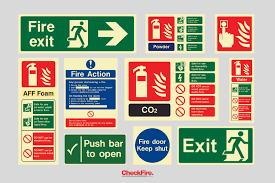Passive Fire Protection Services in London & the Home Counties
Safeguard your building’s structure and occupants with expertly designed passive fire protection systems.
Passive fire protection is essential. Built into your building, fire-resistant materials and systems slow the spread of fire and smoke, protect escape routes, and limit potential damage. Effective PFP also helps emergency responders manage incidents more efficiently.
Across London, Surrey, and the Home Counties, Surrey Fire & Safety delivers practical, compliant solutions for commercial, residential, and industrial properties.
Our team ensures your premises remain resilient, reducing fire risks while meeting all statutory requirements.
Contact UsWhat Is Passive Fire Protection & Why It Matters
Passive fire protection (PFP) forms a crucial layer of defense in your building’s fire safety strategy. Unlike active systems such as all the different types of fire extinguishers, sprinklers or traditional and wireless fire alarms, passive systems are built into the structure to contain and slow the spread of fire and smoke, while protecting high-risk areas such as plant rooms, server rooms, kitchens, and storage spaces.
Why it matters:
- Protects lives: Gives occupants more time to evacuate safely by slowing fire and smoke spread.
- Safeguards property: Limits damage to critical areas and helps contain fire to its area of origin.
- Maintains business continuity: Reduces operational downtime and financial loss after a fire.
- Supports emergency responders: Provides time and controlled environments for firefighting efforts.
- Highlights hidden risks: Even small issues, like unsealed service penetrations or compromised walls, can create major vulnerabilities, so PFP helps address these proactively.
- Ensures legal compliance: Meets UK regulations including Building Regulations Part B, BS 9999, and the Fire Safety Order 2005.
Surrey Fire & Safety provides comprehensive passive fire protection solutions — from design and installation to inspection and maintenance ensuring your premises remain safe, compliant, and resilient in the event of a fire.
Our Passive Fire Protection Services
Our team delivers tailored solutions for every building, ensuring passive fire protection measures are correctly installed and maintained. Every service we provide is designed to maximise safety, regulatory compliance, and structural resilience.
Fire Stopping and Sealing
Ensures fire and smoke cannot pass through walls, floors, or service penetrations, maintaining the integrity of your building and protecting occupants and property.
Fire Barriers and Cavity Barriers
Limits the spread of fire and smoke through large spaces and concealed cavities, keeping escape routes clear and safeguarding critical areas.
Fire Doors and Frames
Certified fire-rated doors and frames provide reliable protection for escape routes and internal zones, giving confidence that barriers perform when they matter most.
Structural Fire Protection
Protects the building’s load-bearing elements, helping to preserve structural integrity and reduce damage in the event of a fire.
Inspection and Certification
All work is carried out in line with BS 476, BS 9999, and Building Regulations Part B. Detailed reports and photographic evidence are provided after every inspection.
Fire stopping and PFP services in London, Surrey and the Home counties area – get in touch with our team of experts today!
Contact Us
Principles of Passive Fire Protection
Passive fire protection (PFP) is founded on three key principles: containment, compartmentation, and integrity:
- Containment: Fire-resistant walls, floors, ceilings, doors, and seals stop fire and smoke from spreading.
- Fire Compartmentation: The building is divided into fire-resistant zones, helping occupants evacuate safely and protecting critical areas.
- Integrity and Maintenance: All PFP measures must be properly installed, regularly inspected, and maintained to ensure they perform as intended during a fire.
Prevention is the best tool in fire safety. Passive fire protection works quietly within the building itself, controlling the spread of fire and smoke automatically — doing its job in the background without anyone noticing.
Why Choose Surrey Fire & Safety?
- Fully qualified, third-party accredited fire protection specialists
- Decades of experience across commercial, residential, and industrial properties
- Comprehensive documentation and clear reporting
- Fast, reliable service across London, Surrey, and the Home Counties
Book a Passive Fire Protection Survey
Protect your building and ensure compliance today.
Contact Surrey Fire & Safety to book a passive fire protection survey or request a consultation with one of our specialists.
Arrange a callbackPassive Fire Protection – FAQ
What are passive fire protection services?
Passive fire protection (PFP) services typically encompass the design, installation, inspection, and maintenance of building elements that are built into the fabric of the structure to contain fire and smoke. Typical services include sealing service penetrations, installing fire‑rated walls and floors, fitting fire‑doors, applying fire‑resistant coatings to structural steel, and providing cavity barriers.
What is the British standard for passive fire protection?
There is no single “passive fire protection” standard, but key British standards include BS 476 (fire tests on building materials and structures) and BS 9999:2017 (fire safety in the design, management and use of buildings) which includes guidance on compartmentation and fire resistance.
What is the difference between passive and active fire protection?
Passive fire protection involves structural or built‑in measures that contain or slow the spread of fire and smoke without needing activation. By contrast, active fire protection systems require activation or action (manual or automatic) to detect, control, or extinguish a fire (for example sprinklers, alarms).
How is PFP tested and certified?
PFP products and systems are tested according to recognised standards to assess fire‑resistance durations (e.g., EI 30, EI 60). Certification and third‑party accreditation ensure that materials and installed assemblies perform as tested. Regular inspection and maintenance must follow to retain performance.
What are passive fire protection systems?
Passive fire protection systems are combinations of materials, design techniques, and installations integrated into the building structure to:
- Stop or slow fire and smoke spread (e.g., fire‑rated walls, floors, ceilings)
- Maintain structural integrity (e.g., fire‑resistant coatings on steel)
- Protect escape routes and compartments (e.g., fire doors, cavity barriers, service‑penetration seals
Contact Us






